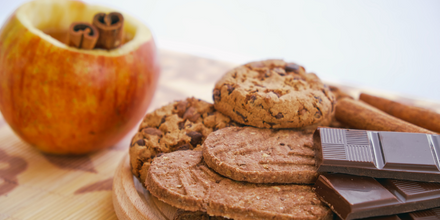Sugar… it’s the buzzword these days! On average, Americans consume more than 20 teaspoons of sugar daily. Diets that are high in sugar are linked to an increased risk of obesity, diabetes and heart disease. Yet despite health concerns, sugar is everywhere. It’s in places you’d obviously expect such as cookies, cakes and sweet drinks, but it’s also found naturally in foods like apples, blueberries and skim milk. To make matters even more complex, there are also artificial sugar substitutes that makes food and drinks sweet without the extra calories.
Added Vs. Natural Sugar
Sugar is a carbohydrate that your body converts into energy. It’s a sweet substance made of crystals from various plants. Many times, it’s used to sweeten food and drinks and is added to products during processing.
Sugar is in everything—drinks, cookies, yogurt and even salad dressing. However, it doesn’t provide any nutritional value. It only adds calories. The American Heart Association recommends no more than 6% of your calories come from added sugar, about 6-9 teaspoons (25-36 grams).
Natural sugar is different. Instead of being added to food, it’s found naturally in that food. For example, milk contains a natural sugar called lactose which gives milk a slight sweetness. Fructose is a naturally occurring sugar found in fruit. You will also find natural sugar in vegetables like sweet potatoes and peas.
Your body recognizes sugar when it’s breaking down food to absorb, but it doesn’t always distinguish between natural and added. There’s a big difference! Let’s take an apple vs. a cookie. An apple has 15 grams of carbohydrates and natural sugar. In that sweet-tasting apple, you’ll also get fiber, water, vitamins and minerals. Your body will also take a while to digest and absorb the apple. When you choose a cookie, you’re missing all the nutrition left with only the sugar! Additionally, foods with added sugars are typically more processed and have a higher concentration of them.
Is Natural Sugar a Free-for-All?
Should you limit natural sugars or should they be a free-for-all? Even though a sugar can be natural, it still has its limits. For example, some foods with natural sugars can still be high in calories. Since these foods don’t have added sugar, many people see them as “free” and “healthy” without considering calories and portion size. That’s why it’s recommended to manage your portion sizes when eating these foods.
Foods Higher in Natural Sugar:
- 1 tablespoon of honey – 17 grams of sugar/64 calories
- 1 cup of fruit juice – 25 grams of sugar/115 calories
- 1/2 cup of dried fruit – 32 grams of sugar/166 calories
Foods Lower in Natural Sugar:
- 1 small apple – 15 grams of sugar/80 calories
- 1 cup of 2% milk – 12 grams of sugar/120 calories
- 1 small sweet potato – 9 grams of sugar/100 calories
What About Substitutes?
With America’s plan to cut back on sugar, many people now rely on sugar substitutes to get that “sweet taste” without the extra calories. These substitutes are non-nutritive because they don’t provide any other benefits such as vitamins, minerals and fiber. Their only advantage is that they have very few or zero calories. For those who are managing their weight, getting that “sweet taste” without extra calories can be beneficial.
Examples of FDA-approved sweeteners include:
- Aspartame (Equal)
- Sucralose (Splenda)
- Acesulfame K (Sweet One)
And to Wrap it Up…
Now you know…sugar is everywhere! Awareness is key to making healthy choices. Knowing the recommendations for added sugar and knowing a food’s sugar content can help you make informed decisions about your health.





